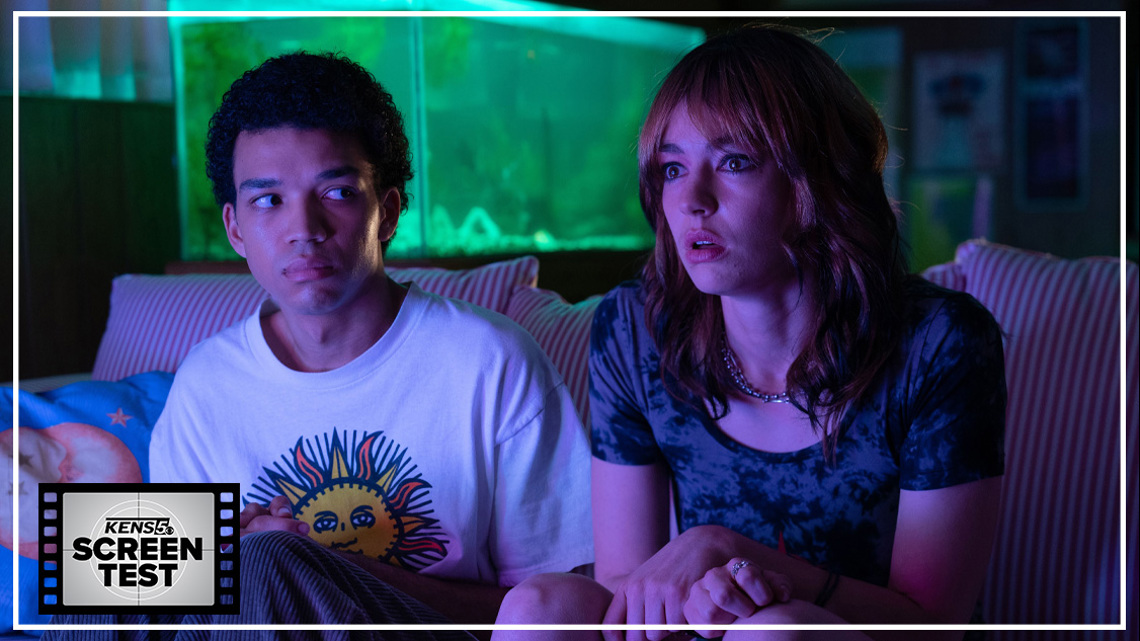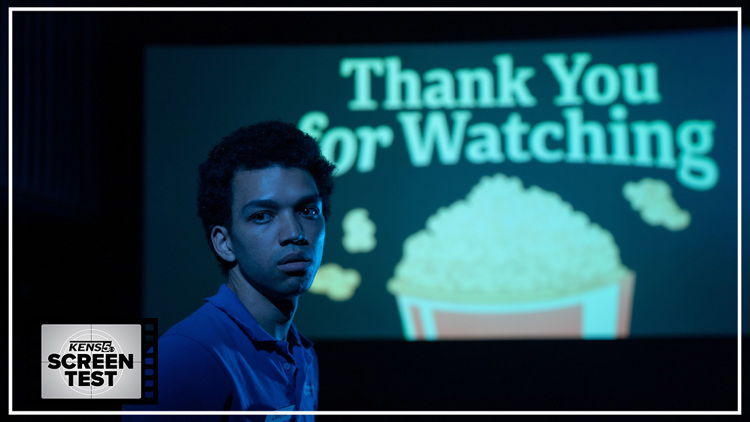TEXAS, USA — It’s 1996 in the world of Jane Schoenbrun’s “I Saw the TV Glow” and seventh grader Owen (Ian Foreman) is curious—curious about the slightly older girl sitting off to the side of a lunchroom-turned-polling place, curious about the official episode guide for a fantasy TV show she’s reading, curious about that TV show itself, “The Pink Opaque,” despite or maybe especially because it comes on after his bedtime. But the pull of the shows ad’s are powerful – what we might see as amusingly lo-fi captivates the boy like sermon – and so too is Owen’s genuine curiosity to this girl, Maddy (Brigette Lundy-Paine), who perhaps has never known true kinship before finding it in the pop cultural rendezvous point of “The Pink Opaque.” She invites him over to watch, permitting him to give in to the comforting glow that shines like a beacon in these lonely suburbs. The impression is a strong one, even if the show doesn’t move him to tears as it does Maddy.
It’s 2010 in a small New Mexico city and the writer whose words you’re reading is a high school sophomore who’s curious—curious about the covers of comic books he’ll never read, curious about the rows of CDs and DVDs whose contents are being increasingly consumed digitally, curious about the old-school action figures that somehow still endure in the age of the internet, when value is, for whatever reason, assigned by anonymous online sellers and not the eye of the beholder. He’s with friends at a store that feels caught between eras, and the pull of that fact means they’re constantly moving, constantly magnetized by various physical media and tools and toys there are now digital approximations for. Being here permits him to indulge his most spontaneous obsessions; some will be fleeting, some will last.
It’s 1998 in “I Saw the TV Glow,” and Owen looks like he’s aged a decade in two years. For one thing, he’s now being played by Justice Smith, and going from the young Foreman to him is like going from Jacob Tremblay to Jacob Elordi. Curiously, Maddy is still played by Lundy-Paine, only now with a different hair style… don’t worry if you’re momentarily distracted by the asymmetry. As we’ll come to see, the more discordant things seem in “I Saw the TV Glow” – a movie whose easy-to-follow opening act belies a psychological instability to come – the closer we feel aligned with Owen’s tangled, strangled trajectory of someone trying to reconcile the identity he’s struggling to grow into with the skin he’s desperate to break out of.
Maddy might know something about that struggle; she’s even lonelier and even more “Pink Opaque”-obsessed than before, and the two communicate through their adoration of the show on a spiritual plane not entirely unlike its fictional heroes. Maddy tapes over episodes, her pink writing scribbled directly onto the screen – “episode 2: this one will make you cry!” – and as Owen trudges through school hallways to grab them, we’re treated to one of the most startlingly touching montages of modern inter-medium communication. It’s made all the more effective for its simplicity, and the dawning realization that Owen, despite nearly being swallowed up in a baggy pink sweater, has aged so much in two years because he’s found in “The Pink Opaque” a marker by which to glimpse his own liberation. Glimpse, but not achieve; Maddy will soon disappear, his pursuit will skid off course and memories being recalled by an older Owen will start to feel suspiciously like they belong to someone else.
It’s 2017 – reality again – and this writer has, well, aged a little bit. So has the world, which now appears close to abandoning its reliance on physical media (the dominance of vinyl notwithstanding). Occasionally he remembers being back at that store; how it felt like going back in time, how he’d always find something new, how the impact of these simple memories grows with time. The store no longer exists, and time’s passage sometimes leads him to wonder if it ever really did. He sometimes can’t remember last month. But he can remember that store, and remembering is often the best he can do. The memories are vivid, even if, he suspects, things didn’t always happen how he thinks they did.
As with Schoenbrun’s 2022 feature debut, “We’re All Going to the World’s Fair,” pacing is nearly everything in the mysterious and achingly moving “I Saw the TV Glow,” even as the writer-director’s follow-up has numerous other merits that harmonize to create the propulsive sensation that Owen is constantly on the verge of being awakened to some great realization. The leaps through time are bigger and arrive increasingly faster, and the effect is what gives this kinda-sorta-not-really-a-horror movie its most acutely horrific accent mark: The suspicion that we’re not seeing things as they happened but instead as recalled by someone past the point of being able to fully embrace himself lest it grate against the norms constantly asserting themselves like "The Pink Opaque's" creepy villains of the week.
The audacity of Schoenbrun’s magnificent second feature starts to come into focus as the certainty of a definitive conclusion doesn’t. Certainty, after all, has always been elusive for Owen, who early on suggests the only thing he knows in his bones is that he likes TV shows. Even in this moment, the deep baritone of his voice is somewhat at odds with the coiled physicality Owen exhibits as a high school freshman, like someone else is trapped in there and desperately needs someone to find him. That certainly fits readings of the film as a story of trans struggle, readings granted legitimacy through Schoenbrun’s own journey as a transfeminine filmmaker and the hints sprinkled throughout this surprisingly rich narrative that Owen isn’t one to accept that the norms he’s grown up with are ones he must prescribe to.


Captured through mesmerizing images of neon-lined darkness, "I Saw the TV Glow" occupies that strange in-between space where intention is the scariest thing in the world because it means potentially letting go of the comfortable and familiar. Schoenbrun embraces that tension: What is most thrillingly apparent in the framework they employ – an increasingly rickety structure that makes you think you’re seeing one thing before assumptions melt away into something formless and intense – is the element of time and how the loss of it affects our identity, the way we see things presently and how that squares (or doesn't) with how we saw them before. Reality is more or less a minefield in “I Saw the TV Glow,” and though the “Pink Opaque” is initially a shelter to Owen and Maddy, its leaden vitality may also be the thing that proves just how terrifying the act of self-actualization can be when the real world’s walls come closing in. Hold on while you can to the ostensibly straightforward events of the opening 45 or so minutes, after which “I Saw the TV Glow” becomes an increasingly slippery, innovative and upsetting work emphasizing the power of narrative in shaping our identities—and the potential fallout of tweaking the antennas for so long that we haven’t noticed the program has ended early.
If the grace Schoenbrun extended to her characters was radical in “We’re All Going to the World’s Fair,” then it feels borderline revolutionary in “I Saw the TV Glow,” a movie whose tides of unease, confusion and catharsis start to crest at a point when it becomes clear that our experience of watching is anchored in Owen’s agency and not our expectations as viewers. Some who watch “I Saw the TV Glow” will, undoubtedly, struggle to find the signal through the static. The beautiful thing is it’s the kind of movie that can help those struggling with where or who they are to make sense of their experience—in turn, potentially, helping others understand their positions too. Memories needn't be our only solace, perhaps, in a more welcoming world.
"I Saw the TV Glow" is now in San Antonio theaters. It's rated PG-13 for violent content, some sexual material, thematic elements and teen smoking. Runtime: 1 hour, 40 minutes.
Starring Justice Smith, Brigette Lundy-Paine, Ian Foreman, Helena Howard
Written and directed by Jane Schoenbrun
2024



